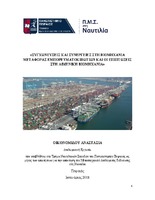Συγχωνεύσεις και συνέργειες στη βιομηχανία μεταφοράς εμπορευματοκιβωτίων και οι επιπτώσεις στη λιμενική βιομηχανία

View/
Keywords
Ναυτιλιακές εταιρείες ; Εμπορευματοκιβώτια ; Διαχειριστές θαλάσσιων τερματικών ; Τερματικά εμπορευματοκιβωτίων ; Ολοκληρώσεις ; Container shipping lines ; Port operators ; Container terminals ; Containers ; IntegrationAbstract
The latest developments in world trade and the huge leaps of technology combined with the economic crisis have reversed most of the well-known data in the industry. Taking into consideration the initial evidence of rapidly growing demand for maritime transport of goods and taking advantage of technology, all shipping lines built vessels with enormous capacity and low fuel consumption (super economically and ecologically efficient). However, the economic crisis has brought down the prices and inability of the shipping lines to fill the space on board, leading companies in the industry to make major changes in their structure and operating activities in order to minimize their losses or, in some cases, even to ensure their sustainability.
This current dissertation aims to describe the current trend in the container industry where the container shipping lines adopt integration strategies creating big alliances and also to report their implications to the port operating companies. Using the bibliographic review method, the first chapter includes a review of the economic situation in recent years and its impact on container shipping. The second chapter analyzes the different types of mergers and acquisitions and the incentives which lead to them. The third chapter describes the types of strategic alliances with emphasis on those prevailing in the container shipping industry. The fourth chapter presents the largest alliances of the industry and finally, the fifth chapter analyzes their impact on container terminals and the response of the port operating companies which was the adoption of corresponding integration strategies.


